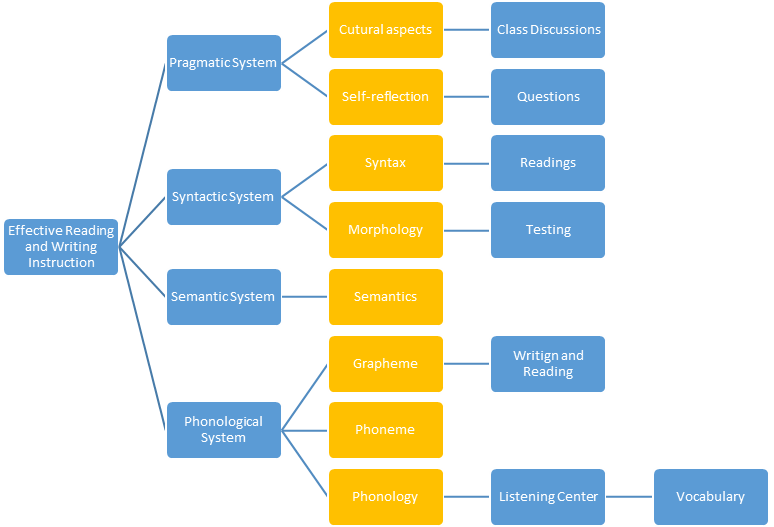Concept Map
The conceptualization of the learning principles and the four-cueing model are critical for the understanding of the required components and the interdependence between them during the teaching process. In this instance, Figure 1 depicts the correlation between the systems while proposing a sequence of steps, which have a beneficial impact on reading and writing instruction in the class.

In this case, Figure 1 represents the elements of the cueing systems while depicting some of the critical components, which form their structure. For instance, cultural aspects and self-reflection signify the pragmatic system, and these levels are emphasized by orange due to its importance. Meanwhile, the next levels portray the potential activities, which can encourage the development of this aspect. It is apparent that some of the matters are not enclosed due to the interdependency of the selected features and the possibility to cover them in one activity simultaneously. For example, the usage of discussions and listening centers could have a beneficial impact on phoneme and semantics as the students will be able to discover new words and determine whether the story or event is applicable in the selected context.
Importance of Learning Theories
The role of the learning theories cannot be underestimated, as they have a tendency to portray the learning process from dissimilar perspectives. Nowadays, the most common tactics are represented by behaviorism, cognitive, humanistic, and social approaches (Leonard, 2002). In this case, the humanistic theory highlights the significance of emotional stability and personal traits in learning (Bates, 2015). Meanwhile, it could be said that the cognitive theory depicts the learning process from a dissimilar perspective while referring it to the neurological impulses (Gould, 2012). Furthermore, the social strategy reflects it from the side of human interactions due to the critical role of the human in the society (Jordan, Carlile, & Stack, 2008).
In turn, the theories could be actively utilized in the classroom to enhance the learning processes while increasing the effectiveness of the learning activities. Meanwhile, these practices could be actively used in the assessment of the students by using observations and checklists. In this case, the observations have a reflection of the behaviorism theory, as the primary emphasis is the changes in the behavior of the learners. Lastly, various activities could be introduced, which require actions and discussions to determine how children act.
Balanced Approach
In turn, the balanced approach is often applied in the classroom settings, and the primary goal of this section is to portray its audial, visual, and kinesthetic experience among the students. Firstly, the balanced approach implies a combination of writing and reading techniques to cultivate the understanding of the particular words and letters in the context while paying equal attention to each component simultaneously (Cohen & Cowen, 2007; Tompkins, 2013). In this case, the observer will be able to see various words displayed on the screen in front of the children with the visual representation of their meanings in the form of images. Meanwhile, each student has a workbook to practice writing of new words and reading texts. The discussion of the questions after the reading, personal stories, and pronunciation of new words could be heard in the classroom. Lastly, the observer will experience the friendly atmosphere as the children happily share their ideas and experiences without being scared of making mistakes.
References
Bates, B. (2015). Learning theories simplified. New York, NY: SAGE Publishers.
Cohen, V., & Cowen, J. (2007). Literacy for children in an information age: Teaching, reading, writing, and thinking. Belmont, CA: Thompson Wadsworth.
Gould, J. (2012). Learning theory and classroom practice in the lifelong learning sector. New York, NY: SAGE Publishers.
Jordan, A., Carlile, O., & Stack, A. (2008). Approaches to learning: A guide to teachers. Berkshire, UK: Open University Press.
Leonard, D. (2002). Learning theories: A to Z. Westport, CT: Greenwood Publishing Group.
Tompkins, G. (2013). Literacy for the 21st century: A balanced approach. New York, NY: Pearson Education.